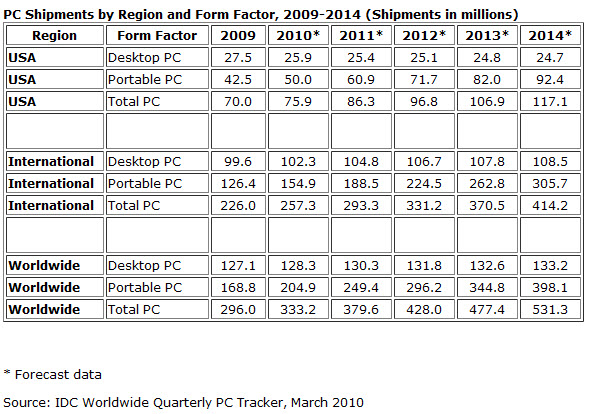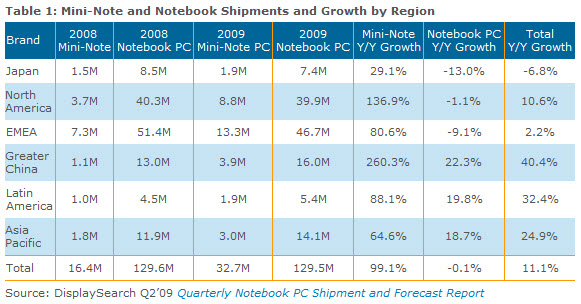Meet Moorestown: Intel's Atom Platform For The Next 10 Billion Devices
Intel’s second-gen Atom platform, Moorestown, positions the chip giant to have a killer smartphone and MID platform in 2010. The old Atom Z5xx drawbacks seem fixed. Why does Moorestown rock, and will it be enough to let Intel advance in this market?
Little, Less, And Loving It
To paraphrase vice president Biden, this is a big f—ing deal. After attending this Moorestown briefing, I walked away fairly convinced that I’d just seen the future of mainstream computing. No, I’m not saying that I think 40% of the market will be toting around Moorestown-based devices next year. I mean that, if certain requisite elements are in place, I see no reason why the median form factor used for computing shouldn’t continue its march from the desktop to the pocket.
Look at these recent numbers from IDC. Desktops are done as a growth vector. Intel and AMD can continue their architectural arms race until the cows come home, but desktop PCs are going to become less and less of a market interest as their static sales become an ever-smaller piece of the computing pie.
In contrast, mobile PC sales are going to more than double in the U.S. over the next five years, and the growth rate worldwide is even higher. Mind you, this only extends down to nettop systems. IDC’s numbers don’t account for handhelds or tablets, which IDC is now “keenly focused on,” according to a recent press release.
Look at the 20-year trend. We’ve gone from a market comprised almost entirely of desktops to one now dominated by laptops. Mobile PCs started outselling their desktop counterparts back in mid-2005. Netbooks arrived in earnest during 2008, and now the diminutive form factor seems to be cannibalizing notebooks. Last year, NPD reported that “once they got home, 60 percent of buyers said they never even took their netbooks out of the house.” In July 2009, DisplaySearch released netbook sales numbers showing that notebook sales actually decreased, while netbooks grew 136.9% year-over-year.
If the mainstream computing market is really more about decreasing size than increasing speed or functionality, then it should have come as no surprise a month ago when Bloomberg Businessweek ran an article that said despite netbooks accounting for 26% of all PCs sold during the prior holiday season, “netbooks' popularity may already have peaked.” IDC numbers show netbook growth plummeting from prior-year levels. The article indicates that while several factors may be behind a 2010 fall-off in netbook interest, the arrival of Apple’s iPad and its imminent horde of competitors may be to blame as the industry looks for “the next big thing.”
Add it all up. While no one disputes that desktops will remain important for several applications, particularly at the high-end, the mainstream will continue to place its dollars into smaller form factors. The only reason people haven’t viewed smartphones as computing devices so far is because they haven’t been powerful enough to take over mainstream computing needs. With Moorestown, I believe we’ve reached a crossover point where that’s no longer the case, and if that’s the case, we’re now in a place where your next phone may also be your next PC.
Get Tom's Hardware's best news and in-depth reviews, straight to your inbox.
Current page: Little, Less, And Loving It
Prev Page Intel’s Ultramobile Future Arrives Next Page Checking Checkboxes-
yannifb Huh, i wonder how this will compete with Bobcat, which supposedly will have 90% of desktop chip performance according to AMD.Reply -
descendency Why isn't this a 32nm product yet? If your concern (which it would be with said devices) is power consumption, shrinking the die can only help...Reply -
Greg_77 silverx75Man, and the HTC Incredible just came out....Man, and I just got the HTC Incredible... ;)Reply
And so the march of technology continues! -
well we can only wait till amd gets their ULV chips out with their on die graphics so we can get a nice comparison.Reply
-
williamvw descendencyWhy isn't this a 32nm product yet? If your concern (which it would be with said devices) is power consumption, shrinking the die can only help...Time to market. 45 nm was quicker for development and it accomplished what needed to get done at this time. That's the official answer. Unofficially, sure, we all know 32 nm will help, but this is business for consumers. Right or wrong, you don't play all of your cards right away.Reply
-
seboj I've only had time to read half the article so far, but I'm excited! Good stuff, good stuff.Reply -
burnley14 This is more exciting to me than the release of 6-core processors and the like because these advances produce tangible results for my daily use. Good work Intel!Reply -
ta152h Do we really need x86 plaguing phones now? Good God, why didn't they use a more efficient instruction set for this? Compatibility isn't very important with the PC, since all the software will be new anyway.Reply
I like the Atom, but not in this role. x86 adds inefficiencies that aren't balanced by a need for compatibility in this market.

